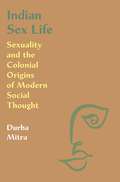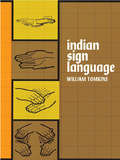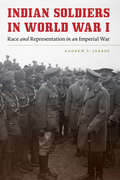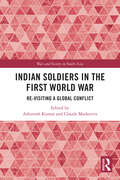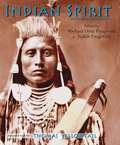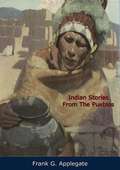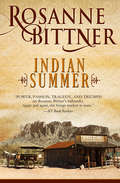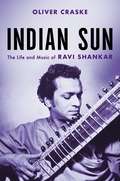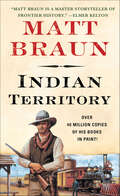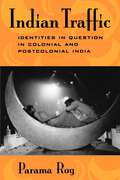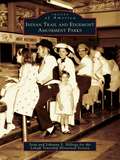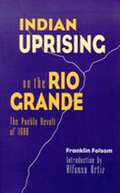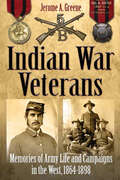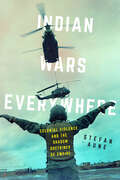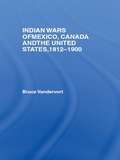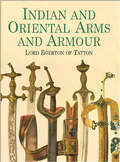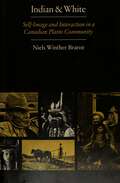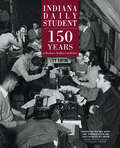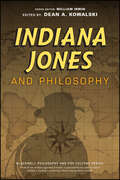- Table View
- List View
Indian Sex Life: Sexuality and the Colonial Origins of Modern Social Thought
by Durba MitraDuring the colonial period in India, European scholars, British officials, and elite Indian intellectuals—philologists, administrators, doctors, ethnologists, sociologists, and social critics—deployed ideas about sexuality to understand modern Indian society. In Indian Sex Life, Durba Mitra shows how deviant female sexuality, particularly the concept of the prostitute, became foundational to this knowledge project and became the primary way to think and write about Indian society.Bringing together vast archival materials from diverse disciplines, Mitra reveals that deviant female sexuality was critical to debates about social progress and exclusion, caste domination, marriage, widowhood and inheritance, women's performance, the trafficking of girls, abortion and infanticide, industrial and domestic labor, indentured servitude, and ideologies about the dangers of Muslim sexuality. British authorities and Indian intellectuals used the concept of the prostitute to argue for the dramatic reorganization of modern Indian society around Hindu monogamy. Mitra demonstrates how the intellectual history of modern social thought is based in a dangerous civilizational logic built on the control and erasure of women's sexuality. This logic continues to hold sway in present-day South Asia and the postcolonial world.Reframing the prostitute as a concept, Indian Sex Life overturns long-established notions of how to write the history of modern social thought in colonial India, and opens up new approaches for the global history of sexuality.
Indian Shoes
by Cynthia Leitich SmithThe beloved chapter book by New York Times bestselling author Cynthia Leitich Smith about the love and adventures shared by a Cherokee-Seminole boy and his Grampa now has brand-new illustrations! A perfect pick for new readers.What do Indian shoes look like, anyway? Like beautiful beaded moccasins... or hightops with bright orange shoelaces?Ray Halfmoon prefers hightops, but he gladly trades them for a nice pair of moccasins for his grampa. After all, it's Grampa Halfmoon who's always there to help Ray get in and out of scrapes—like the time they teamed up to pet sit for the whole block during a holiday blizzard!Award-winning author Cynthia Leitich Smith writes with wit and candor about a boy and his grandfather, sharing all their love, joy, and humor.In partnership with We Need Diverse Books
Indian Sign Language (Native American)
by William TomkinsLearn to communicate without words with these authentic signs! Learn over 525 signs developed by the Sioux, Blackfoot, Cheyenne, Arapahoe, and other tribes. Written instructions and diagrams show you how to make the words and construct sentences. Book also contains 290 pictographs (language in pictures) of the Sioux and Ojibway tribes.
Indian Soldiers in World War I: Race and Representation in an Imperial War (Studies in War, Society, and the Military)
by Andrew T. JarboeThird place in the 2022 SAHR Templer Best First Book Prize More than one million Indian soldiers were deployed during World War I, serving in the Indian Army as part of Britain&’s imperial war effort. These men fought in France and Belgium, Egypt and East Africa, and Gallipoli, Palestine, and Mesopotamia. In Indian Soldiers in World War I Andrew T. Jarboe follows these Indian soldiers—or sepoys—across the battlefields, examining the contested representations British and Indian audiences drew from the soldiers&’ wartime experiences and the impacts these representations had on the British Empire&’s racial politics. Presenting overlooked or forgotten connections, Jarboe argues that Indian soldiers&’ presence on battlefields across three continents contributed decisively to the British Empire&’s final victory in the war. While the war and Indian soldiers&’ involvement led to a hardening of the British Empire&’s prewar racist ideologies and governing policies, the battlefield contributions of Indian soldiers fueled Indian national aspirations and calls for racial equality. When Indian soldiers participated in the brutal suppression of anti-government demonstrations in India at war&’s end, they set the stage for the eventual end of British rule in South Asia.
Indian Soldiers in the First World War: Re-visiting a Global Conflict (War and Society in South Asia)
by Ashutosh Kumar and Claude MarkovitsThis book explores the lives and social histories of Indians soldiers who fought in the First World War. It focuses on their motivations, experiences, and lives after returning from service in Europe, Mesopotamia, East Africa, and Palestine, to present a more complete picture of Indian participation in the war. The book looks at the Indian support to the war for political concessions from the British government and its repercussions through the perspective of the role played by more than one million Indian soldiers and labourers. It examines the social and cultural aspects of the experience of fighting on foreign soil in a deadly battle and their contributions which remain largely unrecognised. From micro-histories of fighting soldiers, aspects of recruitment and deployment, to macro-histories connecting different aspects of the War, the volume explores a variety of themes including: the material incentives, coercion and training which converted peasants into combatants; encounters of travelling Indian soldiers with other societies; and the contributions of returned soldiers in Indian society. The book will be useful to researchers and students of history, post-colonial studies, sociology, literature, and cultural studies as well as for those interested in military history, World War I, and colonial history.
Indian Spirit, Revised and Enlarged
by Judith Fitzgerald Michael Oren FitzgeraldThrough its striking combination of stirring oratory and majestic portraiture from the Plains Indian pre-reservation &“old-timers,&” Indian Spirit reveals the very heart of the traditional Native American life-way: a world where dignity of soul, nobility of sentiments, discipline of gesture, and a sense of the Great Spirit in all things, reigned supreme. This heroic ideal of the Native American, blending the courage of the warrior with the wisdom of the priest, stands as a timeless exemplar for all peoples.
Indian Stories From The Pueblos: Tales Of New Mexico And Arizona (Beautiful Rio Grande Classics Ser.)
by Frank G. ApplegateIndian Stories from the Pueblos is a combination of tales of early Pueblo days and stories from 1929, when the book was first published. They were written by Frank Applegate, a New Mexican artist who lived among the Pueblos.Contains beautiful illustrations from original Pueblo Indian paintings and a foreword by Witter Bynner.
Indian Sufism since the Seventeenth Century: Saints, Books and Empires in the Muslim Deccan (Routledge Sufi Series #Vol. 18)
by Nile GreenSufism is often regarded as standing mystically aloof from its wider cultural settings. By turning this perspective on its head, Indian Sufism since the Seventeenth Century reveals the politics and poetry of Indian Sufism through the study of Islamic sainthood in the midst of a cosmopolitan Indian society comprising migrants, soldiers, litterateurs and princes. Placing the mystical traditions of Indian Islam within their cultural contexts, this interesting study focuses on the shrines of four Sufi saints in the neglected Deccan region and their changing roles under the rule of the Mughals, the Nizams of Haydarabad and, after 1948, the Indian nation. In particular Green studies the city of Awrangabad, examining the vibrant intellectual and cultural history of this city as part of the independent state of Haydarabad. He employs a combination of historical texts and anthropological fieldwork, which provide a fresh perspective on developments of devotional Islam in South Asia over the past three centuries, giving a fuller understanding of Sufism and Muslim saints in South Asia.
Indian Summer
by Rosanne BittnerIn this historical romance novella by the author of Love&’s Bounty, a handsome Cheyenne man shakes up the life of a sheltered preacher&’s wife. Maggie Gibbons leads a happy, if sheltered life on the frontier with her husband, a preacher, and their daughter. But her husband's increasingly cold and unfeeling ways trouble her, as does his disdain for the Cheyenne his mission is to convert. His unwavering beliefs have left her questioning how she feels, and even their relationship. One chance encounter with Wild Horse, a gentle soul who the frontier soldiers have painted as savage, cements what she knows to be true: her husband, her neighbors, her community were all wrong. But will her secret encounters with Wild Horse set her free—or lead her into a world of sin?Praise for USA Today–bestselling Author Rosanne Bittner &“Power, passion, tragedy, and triumph are Rosanne Bittner&’s hallmarks. Again and again she brings readers to tears.&”—RT Book Reviews
Indian Summer: The Secret History of the End of an Empire
by Alex Von TunzelmannThe stroke of midnight on 15 August 1947 liberated 400 million Indians from the British Empire. One of the defining moments of world history had been brought about by a tiny number of people, including Jawaharlal Nehru, the fiery prime minister-to-be; Gandhi, the mystical figure who enthralled a nation; and Louis and Edwina Mountbatten, the glamorous but unlikely couple who had been dispatched to get Britain out of India without delay. Within hours of the midnight chimes, however, the two new nations of India and Pakistan would descend into anarchy and terror. INDIAN SUMMERdepicts the epic sweep of events that ripped apart the greatest empire the world has ever seen, and reveals the secrets of the most powerful players on the world stage: the Cold War conspiracies, the private deals, and the intense and clandestine love affair between the wife of the last viceroy and the first prime minister of free India. With wit, insight and a sharp eye for detail, Alex von Tunzelmann relates how a handful of people changed the world for ever.
Indian Sun: The Life and Music of Ravi Shankar
by Oliver CraskeThe definitive biography of Ravi Shankar, one of the most influential musicians and composers of the twentieth century, told with the cooperation of his estate, family, and friendsFor over eight decades, Ravi Shankar was India's greatest cultural ambassador. He was a groundbreaking performer and composer of Indian classical music, who brought the music and rich culture of India to the world's leading concert halls and festivals, charting the map for those who followed in his footsteps. Renowned for playing Monterey Pop, Woodstock, and the Concert for Bangladesh--and for teaching George Harrison of The Beatles how to play the sitar--Shankar reshaped the musical landscape of the 1960s across pop, jazz, and classical music, and composed unforgettable scores for movies like Pather Panchali and Gandhi.In Indian Sun: The Life and Music of Ravi Shankar, writer Oliver Craske presents readers with the first full portrait of this legendary figure, revealing the personal and professional story of a musician who influenced--and continues to influence--countless artists. Craske paints a vivid picture of a captivating, restless workaholic--from his lonely and traumatic childhood in Varanasi to his youthful stardom in his brother's dance troupe, from his intensive study of the sitar to his revival of India's national music scene. Shankar's musical influence spread across both genres and generations, and he developed close friendships with John Coltrane, Philip Glass, Yehudi Menuhin, George Harrison, and Benjamin Britten, among many others. For ninety-two years, Shankar lived an endlessly colorful and creative life, a life defined by musical, emotional, and spiritual quests--and his legacy lives on.Benefiting from unprecedented access to Shankar's archives, and drawing on new interviews with over 130 subjects--including his second wife and both of his daughters, Norah Jones and Anoushka Shankar--Indian Sun gives readers unparalleled insight into a man who transformed modern music as we know it today.
Indian Territory
by Matt BraunThe railroad’s drive to close the great distances of the wild American West was treacherous. One man was hired to troubleshoot—and, along the way, he grew to admire the Indian way of life….and a Cherokee maiden. When hired gun John Ryan heads into Indian Territory with a brawling crew of railroad workers, a battle of bloodshed and treachery ensues. But when he later meets the proud Cherokees—and the beautiful daughter of and embattled chief—Ryan sees for himself how his employer’s steel rails are splitting the heart of a people’s last home. Can his conscience keep him from pulling the trigger?
Indian Traffic: Identities in Question in Colonial and Postcolonial India
by Parama RoyThe continual, unpredictable, and often violent "traffic" between identities in colonial and postcolonial India is the focus of Parama Roy's stimulating and original book. Mimicry has been commonly recognized as an important colonial model of bourgeois/elite subject formation, and Roy examines its place in the exchanges between South Asian and British, Hindu and Muslim, female and male, and subaltern and elite actors. Roy draws on a variety of sources—religious texts, novels, travelogues, colonial archival documents, and films—making her book genuinely interdisciplinary. She explores the ways in which questions of originality and impersonation function, not just for "western" or "westernized" subjects, but across a range of identities. For example, Roy considers the Englishman's fascination with "going native," an Irishwoman's assumption of Hindu feminine celibacy, Gandhi's impersonation of femininity, and a Muslim actress's emulation of a Hindu/Indian mother goddess. Familiar works by Richard Burton and Kipling are given fresh treatment, as are topics such as the "muscular Hinduism" of Swami Vivekananda.Indian Traffic demonstrates that questions of originality and impersonation are in the forefront of both the colonial and the nationalist discourses of South Asia and are central to the conceptual identity of South Asian postcolonial theory itself.
Indian Trail and Edgemont Amusement Parks (Images of America)
by Lehigh Township Historical Society Johanna S. Billings Sean BillingsIndian Trail and Edgemont Amusement Parks highlights the history of two legendary amusement parks in Lehigh Township. Unique images cover Indian Trail Park from its founding by Samuel and William Solliday in 1929 to its closing in 1984. Photographs of Edgemont Park recall its days as a trolley park, started by the Blue Ridge Traction Company. These images are sure to bring back memories of the rides, games, and thrills that kept people coming back year after year.
Indian Uprising on the Rio Grande: The Pueblo Revolt of 1680
by Franklin FolsomThis award-winning account of the Pueblo Revolt, originally published in 1973 as Red Power on the Rio Grande, is told from the point of view of the Native American villagers of the Rio Grande Valley. Folsom equates the Pueblos' desire to control their own destiny to that of the Americans in 1776 and reveals the harshness of Spanish rule. Not only were the Pueblos taxed and forced to labor for the Spanish, they were frequently sold into slavery and their religion was attacked and suppressed by missionaries. Under the direction of Pope, the Pueblos overcame their traditional reliance on local leadership and joined together in a brilliantly conceived and successful attack on Spanish power. This pivotal time in Pueblo history is powerfully and compelling retold here.
Indian War Veterans: Memories of Army Life and Campaigns in the West, 1864–1898
by Jerome A. GreeneThe decades-long military campaign for the American West is an endlessly fascinating topic, and award-winning author Jerome A. Greene adds substantially to this genre with Indian War Veterans: Memories of Army Life and Campaigns in the West, 1864-1898. Greene’s study presents the first comprehensive collection of veteran (primarily former enlisted soldiers’) reminiscences. The vast majority of these writings have never before seen wide circulation. Indian War Veterans addresses soldiers’ experiences throughout the area of the trans-Mississippi West. As readers will quickly discover, the depth and breadth of coverage is truly monumental. Topics include recollections of fighting with Custer and the mutilation of the dead at Little Bighorn, the Fetterman fight, the Yellowstone Expedition of 1873, battles at Powder River and Rosebud Creek, fighting Crazy Horse at Wolf Mountains, Geronimo and the Apache wars, the Ute and Modoc wars, Wounded Knee, and much more. The remembrances also include selections as diverse as “Christmas at Fort Robinson,” “Service with the Eighteenth Kansas Volunteer Cavalry,” and “Chasing the Apache Kid.” These carefully drawn recollections derive from a wide array of sources, including manuscript and private collections, veterans’ scrapbooks, obscure newspapers, and private veterans’ statements. A special introductory essay about Indian war veterans contains new material about their post-service organizations all the way into the 1960s. Complimenting the riveting entries are dozens of previously unpublished photographs. Readers will additionally find a gallery of never-before-seen full-color plates displaying a wide variety of Indian War Veterans’ badges, medals, and associated materials. No other book discusses the post-army lives of these men or presents their recollections of army life as thoroughly as Greene’s Indian War Veterans. This groundbreaking study will appeal to lay readers, historians, site visitors and interpreters, Civil War and Indian wars enthusiasts, collectors, museum curators, and archeologists. "A treasure-trove of original sources on the Indian wars, an essential addition to every library on the subject." --Paul A. Hutton, University of New Mexico, and the author of "Phil Sheridan and his Army and "The Custer Reader." About the Author: Jerome A. Greene is an award-winning author and historian with the National Park Service. His books include The Guns of Independence: The Siege of Yorktown, 1781, Lakota and Cheyenne: Indian Views of the Great Sioux War, 1876-1877, Morning Star Dawn: The Powder River Expedition and the Northern Cheyenne, 1876, and Washita: The U.S. Army and the Southern Cheyennes, 1867-1869. He resides in Colorado.
Indian Wars Everywhere: Colonial Violence and the Shadow Doctrines of Empire (American Crossroads #71)
by Stefan AuneReferences to the Indian Wars, those conflicts that accompanied US continental expansion, suffuse American military history. From Black Hawk helicopters to the exclamation "Geronimo" used by paratroopers jumping from airplanes, words and images referring to Indians have been indelibly linked with warfare. In Indian Wars Everywhere, Stefan Aune shows how these resonances signal a deeper history, one in which the Indian Wars function as a shadow doctrine that influences US military violence. The United States’ formative acts of colonial violence persist in the actions, imaginations, and stories that have facilitated the spread of American empire, from the "savage wars" of the nineteenth century to the counterinsurgencies of the Global War on Terror. Ranging across centuries and continents, Indian Wars Everywhere considers what it means for the conquest of Native peoples to be deemed a success that can be used as a blueprint for modern warfare.
Indian Wars of Canada, Mexico and the United States, 1812-1900
by Bruce VandervortDrawing on anthropology and ethnohistory as well as the ‘new military history’ Indian Wars of Mexico, Canada and the United States, 1812-1900 interprets and compares the way Indians and European Americans waged wars in Canada, Mexico, the USA and Yucatán during the nineteenth century. Fully illustrated with sixteen maps, detailing key Indian settlements and crucial battles, Bruce Vandervort rescues the New World Indian Wars from their exclusion from mainstream military history, and reveals how they are an integral part of global history. Indian Wars of Mexico, Canada and the United States: * provides a thorough examination of the strategies and tactics of resistance employed by Indian peoples of the USA which contrasts practices of warfare with the Métis (the French Canadian-Indian peoples), their Canadian-Indian allies, and the Yaqui and Mayan Indians of Mexico and Yucatán* presents a comparison of the experience of Indian tribes with concurrent resistance movements against European expansion in Africa, exposing how aspects of resistance that seem unique to the New World differ from those with broader implications* draws upon concepts used in recent rewritings of the history of imperial warfare in Africa and Asia, Vandervort also analyzes the conduct of the US Army in comparison with military practices and tactics adopted by colonialist conquests worldwide. This unique and fascinating study is a vital contribution to the study of military history but is also a valuable addition to the understanding of colonialism and attempts to resist it.
Indian and Oriental Arms and Armour (Dover Military History, Weapons, Armor)
by Lord Egerton of TattonOriginally created in the late 19th century to catalog Indian and Oriental arms and armor for a British museum, this volume has long since become a sourcebook of vital information on the military history of India. Enhanced with excellent illustrations, it remains one of the few books available on the subject, providing factual accounts of events ranging from the earliest invasions of the subcontinent in 200 B.C. to the decline of the Mogul Empire (early 18th century) and the First Burmese War in 1824. In addition to information on military history, succeeding chapters describe Indian swords, helmets, knives, shields, daggers, spears, javelins, blowpipes, sabers, and a host of other weapons, including arms used for athletic and sacrificial purposes. Descriptive notes, grouped according to geographical areas, comment on styles of decoration, manufacturing processes, and ethnological characteristics. A shorter section of the book includes detailed information on Arab and Persian arms (maces, battle axes, matchlock guns, bows and arrows, etc.) and Japanese armor. Students of Far Eastern arms and armor as well as enthusiasts of military history will welcome this comprehensive reference. 350 halftones and line illustrations. 350 halftones and line illustrations.
Indian and White: Self-Image and Interaction in a Canadian Plains Community
by Niels Winther BraroeA 1966-67 study of a small band of Cree Indians living in western Canada, analyzing the relations with the white townspeople and ranchers living around them.
Indiana Covered Bridges: Indiana's Covered Bridge Capital
by Rachel Berenson Perry Marsha Williamson MohrA symbol of Indiana's past, the covered bridge still evokes feelings of nostalgia, romance, and even mystery. During the 19th century, over 500 of these handsome structures spanned the streams, rivers, and ravines of Indiana. Plagued by floods, fire, storms, neglect, and arson, today fewer than 100 remain. Marsha Williamson Mohr's photographs capture the timeless and simple beauty of these well-traveled structures from around the state, including Parke County--the unofficial covered bridge capital of the world. With 105 color photographs, Indiana's Covered Bridges will appeal to everyone who treasures Indiana's rich architectural heritage.
Indiana Curiosities: Quirky characters, roadside oddities & other offbeat stuff (Curiosities Series)
by Dick WolfsieYour round-trip ticket to the wildest, wackiest, most outrageous people, places, and things the Hoosier State has to offer!
Indiana Daily Student: 150 Years of Headlines, Deadlines and Bylines (Well House Books)
by Rachel Kipp, Amy Wimmer Schwarb and Charles ScudderThe story of a student-produced newspaper since its debut in 1867—including photos, coverage of historic events, and reminiscences from prominent alumni.Generations of student journalists, armed with notepads, cameras, and a tireless devotion, have pursued both local and national stories for the student-produced newspaper at Indiana University Bloomington since its debut in 1867.In Indiana Daily Student: 150 Years of Headlines, Deadlines and Bylines, editors and IDS alumni Rachel Kipp, Amy Wimmer Schwarb, and Charles Scudder piece together behind-the-scenes remembrances from former IDS reporters and photographers, newsroom images from throughout the decades, and a curated collection of notable IDS front pages. From coverage of the end of World War I to the selection of Herman B. Wells as IU’s president to the Hoosiers’ national basketball championship titles to the terrorist attacks of Sept. 11, 2001, the IDS has chronicled news from a student perspective. Today, it serves as a training ground for fledgling journalists who have gone on to be monumental voices in American and global media.Remembrances from some of the most prominent journalists to emerge from the IDS are included here: among them, publisher and journalism philanthropist Nelson Poynter; National Public Radio television critic Eric Deggans; and Pulitzer Prize winners Ernie Pyle, Thomas French, and Melissa Farlow. While at IU, students at the IDS built and maintained beloved traditions they continue to share today, all while offering a full spectrum of coverage for their readers. The first book on the paper’s history, Indiana Daily Student offers a comprehensive celebration of the newspaper’s achievements, as well as historic front pages, photographs, and personal narratives from current and former IDS journalists.
Indiana Jones and Philosophy: Why Did it Have to be Socrates? (The Blackwell Philosophy and Pop Culture Series)
by William IrwinINDIANA JONES AND PHILOSOPHY What does it mean to choose wisely? Can heroes seek fortune and glory? Why does Indy take a leap of faith? Do Indy’s adventures provide him evidence of the supernatural? Should we hide the Ark of the Covenant in a military-controlled warehouse? Why are museums so important to archaeology? If adventure has a name, it must be Indiana Jones! He’s both a mild-mannered archaeology professor and an intrepid adventurer traversing the globe in search of lost artifacts. Whether seeking the Ark of the Covenant in Egypt, the Sankara Stones in India, the Holy Grail in Turkey, or a mysterious crystal skull in Peru, Indy’s adventures never fail to delight audiences. Indiana Jones and Philosophy takes you on a whirlwind journey to investigate some of the most enduring questions about the human condition. You’ll read about how Indy has wronged Marion Ravenwood, how a virtuous person would make amends, the strides Indy makes to repair his relationship with his father, why Indy distinguishes fact from truth when he pursues archaeological treasures, and much more. With trusty guides such as Aristotle, Camus, Kant, and Nietzsche at your side, you’ll consider possible answers to these questions and see Indiana Jones in a whole new light! Comprehensive, immersive, and engaging, Indiana Jones and Philosophy offers you an accessible and lively opportunity to dive deeper into the world of Indiana Jones and appreciate the character’s greatness anew!
